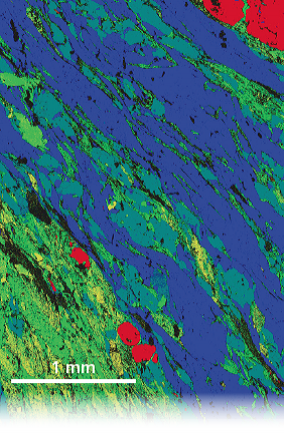Unlocking the secrets of nanoscale structures in fault rocks
In this application note both conventional EBSD and TKD are used, in conjunction with pattern matching, to understand faulting processes in complex earthquake rocks.
The orientation of grains in rocks and the stresses that they hold are powerful indicators of a rock’s history and have strong implications for its physical properties. This means that information on grain textures has uses in both industrial and academic settings where an understanding of these properties is required.

The combination of compositional, textural and crystallographic information from rock samples give a comprehensive insight into how those factors interact to produce the properties of that rock which in turn inform how it should be treated when built on or the conditions under which it was formed or the events that it has been subjected to during its history.
To gain this understanding, multiple sources of information must be combined.
Analysis of geological samples with EBSD and EDS allows both crystallographic and compositional information to be acquired at the same time. This allows compositional variations to be matched to grain textures or preferred orientations or for an additional source of information to be used to identify which phases are present. This in turn informs how the grains formed and what they have been subjected to.
Both deformed and non-deformed samples can be studied – allowing a measure of that deformation to be determined.
Oxford Instruments’ Symmetry CMOS EBSD detector paired with Ultim Max EDS detectors forms the perfect, high sensitivity, high throughput combination for this challenging analysis.
In this application note both conventional EBSD and TKD are used, in conjunction with pattern matching, to understand faulting processes in complex earthquake rocks.
A relatively simple geological sample, a quartz mylonite, is here characterised in a matter of minutes using Symmetry, collecting data at almost 1000 pps.
EBSD identifies crystalline phases on the basis of their particular crystallographic characteristics. However, it has traditionally been a challenge to differentiate between phases with very similar crystal structures.
Reconstructing the metamorphic evolution of rocks often depends on the identification of key minerals that are only stable at specific temperatures and pressures. Combined EBSD and EDS analyses enable more rigorous phase identification than conventional techniques, with the added benefit of providing insights into a rock’s deformation and chemical history.
An eclogite sample containing 10 phases has been rapidly analysed using integrated EBSD and EDS. The performance of Symmetry enables high pattern resolution and good indexing, even at 250 pps.